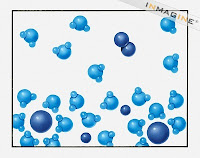We are all familiar with the states of matter (solids, liquids and gases) for many substances. In the First Activity we explored these states of matter for water. In Activity 6, we would like to take our overall understanding of states of matter to the molecular level. We will use the States of Matter simulation at http://phet.colorado.edu/ .
There are two key characteristics of molecules that determine their state of matter. The first one is the temperature of the matter, and the second one is the intermolecular forces (how well atoms/molecules stick to one another) between atoms and molecules.
- One of the first things to think about here is temperature. Temperature and thermometers have a very similar relation to speed and speedometers. For all practical purposes, a thermometer is really a speedometer for molecular speed or motion.
Notice that the Kelvin scale starts at zero and goes up from there. This is like our car speedometer, in that at 0 Kelvin (K), molecular and atomic motions stop. As the temperature rises, atoms and molecules begin to move faster and faster.
- The second thing to consider is the intermolecular forces (attractions) that exist between molecules. In the D2L content slides there are a few types of attractions described, notice all of these are defined by the attraction that exists between positive and negative charges. Water is a great example of a molecule that has strong attractions that we call hydrogen bonding. It is this strong attraction that makes water a unique molecule on our planet. It turns out that the hydrogen atoms tend to be positive in charge, and the oxygen atoms tends to be negative in charge.
2. Complete the Teaching Idea: States of Matter Simulation Lab by Kelly Vaughan:
Name: Visualizethis39/penaj Date: July 25, 2012
Class: Visualizing Chemistry 105, Dr. Shultz
PREDICT
1. Draw a diagram below showing what you think the molecules
will look like for each state of matter, solid, liquid, and gas. Write a
sentence below each diagram predicting what the motion of the molecules will be
like.
Solid
|
Liquid
|
Gas
|
|
Diagram of molecules
|
 |
|
|
Sentence explaining how molecules will be moving.
|
Slowly |
2. If you start with a substance as a solid, what will
happen to the molecules as you add thermal energy (heat)? They will speed up, creating energy.
INVESTIGATE:
3. Use the menu on the right side of the program to select
Water and Solid. Draw and describe what you see in the space below.
Diagram
|
Description
|
4. Now, use the slider on the bottom of the program to Add
Heat. Notice the thermometer at the top of the program. What temperature scale
is this thermometer showing? 157 K
5. What happens to the water as you increase the
temperature? The water molecules separate and move faster due to increasing temperature; speed increases, like a speedometer.
6. What is the melting/freezing point of water in Kelvin? 273.15 K
7. Add heat until the temperature is just below and then
just above the melting point of water. How is water different below its melting
point and above it? In the melting point the water is becoming a liquid, getting colder, and at boiling point the water is becoming a gas and is getting hotter therefore moving faster.
8. Draw and describe what water looks like as a liquid.
Diagram
|
Description
|
|
|
10. Continue to add heat until you are just below and then
just above the boiling point of water. How is water different below its boiling
point and above it? Molecules either move slower or faster, decreasing or increasing in pressure and evaporation due to the decreasing or rising of temperature.
11. Draw and describe what water looks like as a gas.
Diagram
|
Description
|
12. Choose one of the other three substances listed in the
menu on the right. Investigate what happens when you add and remove heat from
this substance. Use the buttons on the right to see this substance as a solid,
liquid, and gas. Draw and describe its properties in the table below.
Substance Selected: Oxygen
Gas: The particles of a gas are far apart and move randomly, yet rapidly.
Liquid: aka CO2. The particles of a liquid are free to move within the confines of the liquid; no organized pattern.
Solid: The particles of a solid have fixed positions and exhibit motions of vibrations; bounce off of each other.
ANALYZE:
13. How was this substance similar to water in each state of
matter? How was it different? Although different states of matter, oxygen acts almost identical to water in the means of how fast or slow they move due to increasing or decreasing temperature. The major difference, however, is that CO2 is produced from oxygen.
14. Were your predictions (see p. 1) correct or incorrect?
Explain. Yes, my predictions were correct because molecules speed up with an increased temperature and vise versa.
15. Choose a substance other than water from the menu on the
right side of the program. Use the slider to add and remove heat. Based on what
the molecules do, figure out the approximate temperatures of the melting point
and boiling point of this substance. (Hint: The temperatures given when you
click solid, liquid, and gas are NOT the melting and boiling points.)
Substance: Neon
Melting Point: 25 K
How did you figure it out? Because the molecules start to move more slowly.
Boiling Point: 27 K
How did you figure it out? The exact point couldn't be determined because of the molecules moving rapidly.
Dipole forces are oppositely charged ends and will attract each other. For example, hydrogen bonds are created when a hydrogen atom is covalently bonded to a high electronegative atom.
5. List and describe at least two Science Standards that this activity addresses.
Content Science G, Applications and Content Standard Science D, Physical Science.







No comments:
Post a Comment